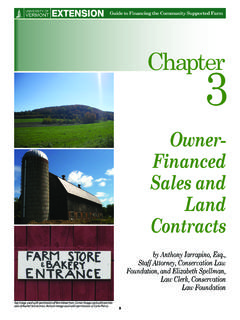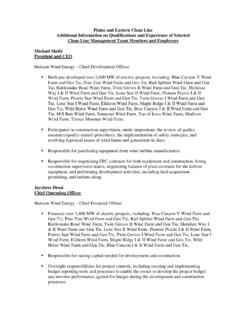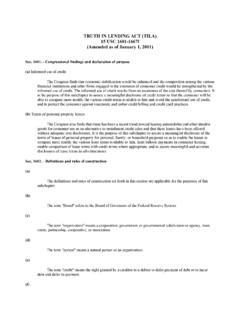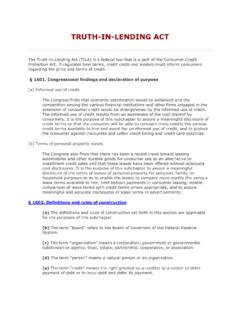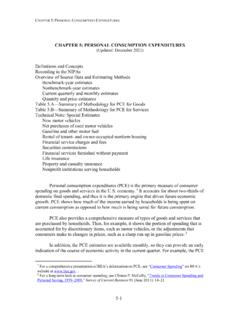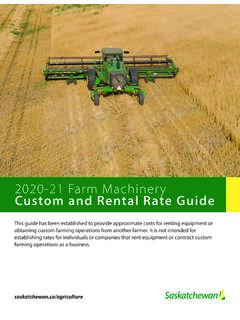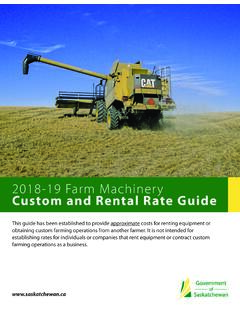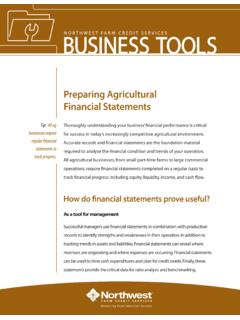Transcription of AGRICULTURAL COMMERCILIZATION IN ETHIOPIA
1 AGRICULTURAL Commercialization in ETHIOPIA : A Review of Warehouse Receipts in the Maize, Wheat, Sorghum and Tef Value ChainsAGRICULTURALCOMMERCILIZATIONIN ETHIOPIA :A Review Of Warehouse Receipts In The Maize, Wheat, Sorghum And Tef Value ChainsAugust 2017 This publication was produced at the request of the AGRICULTURAL Transformation Agency (ATA). It was prepared independently by Tufts University. The author of the report is Sally Commercialization in ETHIOPIA : A Review of Warehouse Receipts in the Maize, Wheat, Sorghum and Tef Value ChainsAgricultural Commercialization in ETHIOPIA : A Review of Warehouse Receipts in the Maize, Wheat, Sorghum and Tef Value ChainsAugust 2017 USAID Contract number: AID-663-C-14-00002 Agriculture Knowledge, Learning, Documentation and Policy (AKLDP) ProjectImplemented by:Feinstein International CenterFriedman School of Nutrition Science and PolicyTufts University Africa Regional OfficePO Box 1078 Addis AbabaEthiopiaTel: +251 (0)11 Suggested citationPauw, S.
2 (2017). AGRICULTURAL Commercialization in ETHIOPIA : A Review of Warehouse Receipts in the Maize, Wheat, Sorghum and Tef Value Chains. USAID/ ETHIOPIA Agriculture Knowledge, Learning, Documentation and Policy Project, Addis Ababa DisclaimerThe views expressed in this report do not necessarily reflect the views of the United States Agency for International Development or the United States in particular to Adrian Cullis, former AKLDP Chief of Party, for initiating this study. Advice, feedback and technical assistance from Mirafe Marcos, Fekadu Tilahun, Gebre Egziabner Abay, Zewdu Abera and Karl Pauw are greatly acknowledged. AGRICULTURAL Commercialization in ETHIOPIA : A Review of Warehouse Receipts in the Maize, Wheat, Sorghum and Tef Value ChainsTABLE OF CONTENTSLIST OF TABLES, FIGURES AND BOXESACRONYMS EXECUTIVE SUMMARY1.
3 INTRODUCTION2. ETHIOPIA S WAREHOUSE RECEIPT SYSTEM AND THE SUPPORTING ENVIRONMENT Establishment of the WRS, ECX, and EACWSE WRS utilization and performance The AGP-AMDe roadmap: recommendations pertaining to the WRS AGRICULTURAL Commercialization Clusters and the WRS Community WRS: Successes and challenges Information Communication Technology (ICT) requirements Financial institutions and WRF Private sector3. PRIORITY COMMODITY MARKET ANALYSIS Technical assessment of storability Price trends and seasonality4. CONCLUSIONS AND RECOMMENDATIONS5. REFERENCES6. APPENDIX iiiivv1 334 5910111214161616202427iiAgricultural Commercialization in ETHIOPIA : A Review of Warehouse Receipts in the Maize, Wheat, Sorghum and Tef Value ChainsLIST OF TABLES, FIGURES AND BOXEST able 1.
4 Assessed storage capacity in ETHIOPIA , by storage ownerTable 2. Markets selected for price analysisTable 3. Correlation coefficients between market pairs, 2011 2017 Figure 1. Warehouse receipt finance disbursements (ETB): 2011-2012 Figure 2. ACC integration with IAIPs and the LMPF igure 3. Price index of national maize and tef prices, 2012 2016 Figure 4. Price index of national wheat and barley prices, 2012 2016 Figure 5. Schematic representation of an integrated WRS in EthiopiaFigure 6. ACCs in OromiaFigure 7. ACCs in AmharaFigure 8. ACCs in TigrayFigure 9. ACCs in SNNPBox 1. The AGRICULTURAL Storage and Investment Facility in MalawiBox 2. Forward contractsBox 3. Malting Factory Example731325101819222728293081315iiiAgr icultural Commercialization in ETHIOPIA .
5 A Review of Warehouse Receipts in the Maize, Wheat, Sorghum and Tef Value ChainsACRONYMSACC AGRICULTURAL Commercialization ClustersACE AGRICULTURAL Commodity Exchange for AfricaAGP-AMDe AGRICULTURAL Growth Program-Agribusiness and Market DevelopmentATI Africa Trade InsuranceATA AGRICULTURAL Transformation AgencyCBE Commercial Bank of EthiopiaCRDB Community Rural Development Bank (Tanzania)CRS Community Warehouse Receipt SystemCSP Cooperative Storage PlanDFIs Development Finance InstitutionsEABC Ethiopian AGRICULTURAL Business Corporation (former AGRICULTURAL Input Supply Enterprise and the former Ethiopian Seed Enterprise) EACWSE ETHIOPIA AGRICULTURAL Commodities Warehouse Services EnterpriseECAs Export Credit AgenciesECEA Ethiopian Commodities Exchange AuthorityECX WRS ETHIOPIA Commodity Exchange Warehouse Receipts SystemECX ETHIOPIA Commodity ExchangeEDRI Ethiopian Development Research InstituteEGTE Ethiopian Grain Trade EnterpriseEIB European Investment BankEIIDE Ethiopian Industrial Inputs Development Enterprise (former Merchandise Wholesale & Import Trade Enterprise)ETB Ethiopian BirrETBC Ethiopian Trading Business Corporation (former Ethiopian Trading Enterprise, EGTE, ETFruit)
6 FAO Food and Agriculture OrganizationFCU Farmer Cooperative UnionGRN Goods Received NoteGTP II Growth and Transformation Plan IIIAIPs Integrated Agro-Industrial ParksICT Information Communication TechnologyIFAD International Fund for AGRICULTURAL DevelopmentIFC International Finance CorporationLMP Livestock Master PlanMFI Micro Finance InstituteNBM National Bank of MalawiNDRMC National Disaster Risk Management CommissionPC Primary CooperativePO Primary OrganizationRIA Research ICT AfricaRUSACOs Rural Saving and Credit CooperativesSFRA Strategic Food Reserve Agency (former Ethiopian Food Security Reserve Administration)SHF Small Holder FarmerSIP Storage Investment PlanUSAID United States Agency for International DevelopmentWR Warehouse ReceiptWRF Warehouse Receipt FinancingWRICO Warehouse Receipts and Inventory Collateral OfficeWRS Warehouse Receipt SystemivAgricultural Commercialization in ETHIOPIA : A Review of Warehouse Receipts in the Maize, Wheat, Sorghum and Tef Value ChainsEXECUTIVE SUMMARYE thiopia s AGRICULTURAL sector has reported considerable growth rates over the past decade as the result of an estimated doubling in the use of modern farm inputs, rapid expansion of arable land, increased labor productivity, government investments in the extension system and an improved road network.
7 The second phase of ETHIOPIA s Growth and Transformation Plan (GTP II) aims to maintain current high levels of AGRICULTURAL GDP growth over the 2015 2020 period. Several of the AGRICULTURAL Transformation Agenda Deliverables for the commercial orientation pillar of GTP II can be directly addressed or strengthened through an efficient Warehouse Receipt System (WRS), including provision of market services and infrastructure, promoting aggregation and storage use and availability, and fostering agro-processing, value addition and exports. It is expected that the Transformation Agenda Deliverables be operationalized in the Government of ETHIOPIA s AGRICULTURAL Commercialization Clusters (ACCs), which aim to provide a strategic and commercially viable platform for the development of priority AGRICULTURAL commodity value chains through a geographically focused approach.
8 It is proposed that the platforms will enable the implementation of multiple priority interventions for AGRICULTURAL transformation-led growth and rural transformation. The primary goal of the ACCs is the commercialization of smallholder agriculture and agro-industrial development, offering a strategic entry point for private sector engagement. ETHIOPIA is considered as one of the pioneers of the Warehouse Receipt System (WRS) in Africa, having first enacted a Proclamation for the Ministry of Trade to implement and regulate such a system in 2003. The ETHIOPIA Commodity Exchange (ECX) was established in 2008 and was assigned the responsibility of managing the WRS. By insuring against operational risks the ECX helped regain confidence from the banks to finance receipts.
9 In 2014 a new regulation led to the establishment of the Ethiopian AGRICULTURAL Commodities Warehousing Service Enterprise (EACWSE), to provide warehouse management services. It was recently announced that the EACWSE would be merged with its mother organization the ECX by 1 July 2017, ostensibly due to the weak performance of the warehouse service provision under EACWSE management. This restructuring of the ECX provides an ideal opportunity to take stock and revisit the question of whether the WRS linked to Warehouse Receipt Finance (WRF) can expedite AGRICULTURAL commercialization in ETHIOPIA , particularly within priority commodity value chains for tef, barley, maize and wheat. Maize and wheat are already eligible for warehouse receipting on the ECX.
10 With one of the core objectives of the ACCs to promote an integrated platform to implement multiple priority interventions across value chains and across sectors, there are several benefits to introducing the WRS to the ACCs. First, the WRS assures quality of produce and same-standard commodities. Second, the WRS promotes market linkages though a common marketable instrument, the WR. Third, value addition can be improved through increasing finance availability in the value chain though Warehouse Receipt Financing (WRF). Finally, the WRS facilitates aggregation. A marketable surplus is a prerequisite for a functioning WRS, however there are three further important requirements for success: first, the storability of the underlying commodity should be high so as to ensure that all the parties have trust that the value of the product is preserved over time; second, the expected seasonal price differential, the gap between the trough and peak prices, should be sufficient to cover the cost of storage and financing; and third, the price should follow a predictable curve over the course of the season as any deviation from the normal seasonal pattern imparts major risk to the parties involved.

